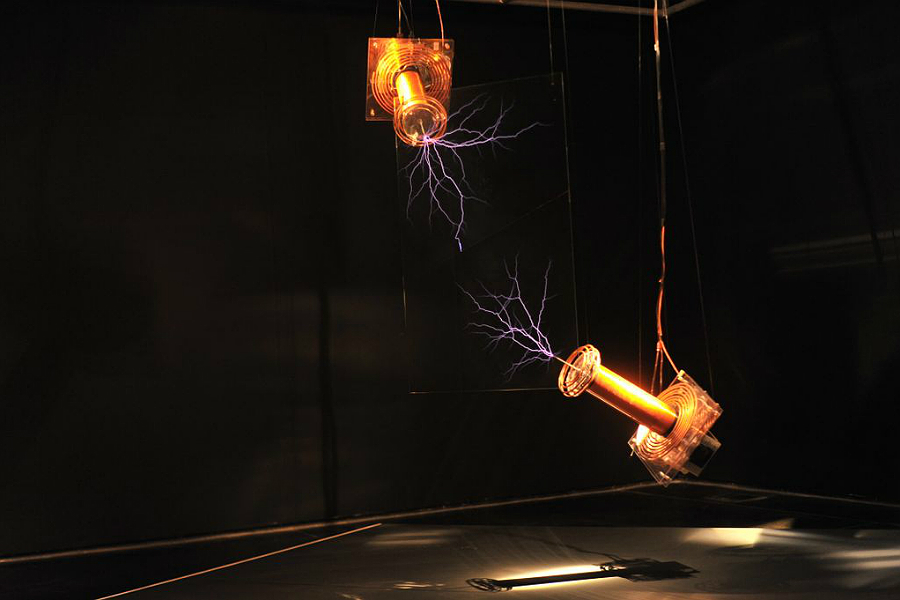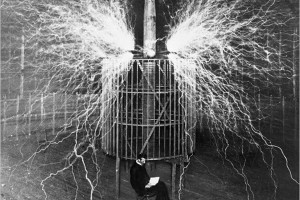Nikola Tesla: the man who invented the 20th Century

Winter Sparks, the new exhibition at FACT, leads us to ponder the man and the myth that is Nikola Tesla…
The thing you can’t ignore walking through the three large-scale installations making for quite the sound and light show in FACT’s new Winter Sparks exhibition is our continuing fascination with electricity; how it looks, how it’s conducted and, crucially, where we’d be without it.
Of course, the story of electricity is entwined with human kind’s most giant of giant leaps – names like Thomas Edison and Michael Faraday continue to be widely associated with its development today – while the relationship between art and science stretches even further. However, one name that is perhaps, and mystifyingly, somewhat less renowned in lay-society is that of Nikola Tesla, a genius without whom the 20th century would have looked very different.
However, before the Serbian-born Tesla got very far, he and his burgeoning career fell foul to none other than Edison, who despite employing him also feared that, in Tesla, he had met more than a match for his skill and ingenuity. He wouldn’t be in Edison’s employment for too long; on completing work for which he’d been told “There’s fifty thousand dollars in it for you—if you can do it”, Edison withdrew the offer, claiming Tesla simply didn’t understand the American sense of humour. He resigned on the spot.
But Edison continued to dog his career. When Tesla proposed a move to the more efficient alternating current (A/C) away from Edison’s model (widely in use at the time), the Serb found himself subject to a damaging campaign at the hands of his former employer. In the wake of phony demonstrations attesting to the dangers of A/C (in which Edison went to the lengths of publicly killing animals), Tesla was once again out of work – such was the influence of his nemesis – and forced to take a job digging ditches for $2 a day.
Despite the setbacks, Nikola Tesla would eventually go on to prove his worth and be acknowledged as a scientist and inventor of rare quality. A/C was, of course, eventually found to be safe and reliable, his name is still borne by the Tesla Coil (five of which feature to stunning effect in Impacts, Alexandre Burton’s work for Winter Sparks) and his scientific legacy, quite rightly, is secure.

Beyond those well publicised spats with Edison, the enmity between the pair remained, even leading to rumours that in 1915 they each refused a Nobel Prize for physics upon hearing it would be shared with the other.
Predictably, the pair would never be reconciled, and upon the occasion of Edison’s death in 1931, amongst the glowing obituaries came this from Tesla: “He … lived in utter disregard of the most elementary rules of hygiene [Tesla most likely suffered from OCD] … His method was inefficient in the extreme … and, at first, I was almost a sorry witness of his doings, knowing that just a little theory and calculation would have saved him 90 percent of the labor. He had a veritable contempt for book learning and mathematical knowledge…”
But as with so many gifted people before and after him, Tesla was just as interesting and complicated a subject in private life as he was in his career: he racked up patents for inventions, the final one coming in 1928 for a VTOL aircraft, and continued to work (on a death ray amongst other things, based on, what else, electricity). And while he maintained a dwindling number of friendships (notably with the author Mark Twain) he began increasingly to withdraw from public life.
In keeping with his somewhat mysteriously low profile, there are a number of sketchy details (and sketchier rumours) about the genius, who has been described as having an intellect that “at times seemed unearthly”, that refuse to go away. That his name is so rarely uttered only goes to add to the suspicions and dark conspiracies: he insisted he had invented an electrical generator that consumed no fuel, and much of his work in later life could be filed safely (perhaps kindly) under ‘experimental and/or theoretical’.
That later life was largely spent in residence at the Hotel New Yorker (paid for from 1934 by his former sponsors, the Westinghouse Electric & Manufacturing Company); he would rarely leave his room except to feed the pigeons in the grounds of the nearby cathedral. Indeed, it was probably the pigeons which constituted the closest thing he had to a ‘relationship’ in the latter part of his life, such was the extent that he had withdrawn to the status of a recluse.
In the January of 1943, Tesla died penniless – despite having sold his A/C electricity patents for a relative fortune – and alone (he would never marry), aged 86 in Room 3327 of the New Yorker. Days later, he received a state funeral (Tesla had US citizenship) in New York, reportedly attended by 2000 people. His ashes are kept at the Nikola Tesla Museum, along with (somewhat ghoulishly) his death mask, which was commissioned by long time friend and supporter, Hugo Gernsback.
However, that’s not quite the end of the story. Tesla has been portrayed on numerous occasions in fiction, recently by David Bowie in Christopher Nolan’s The Prestige. Also featuring in that movie was Christian Bale who, if the rumours are true, could be set to play Tesla in a forthcoming biopic with Great Expectations helmsman Mike Newell a potential director. Whether the film will shed greater light on a great man, or only add to the legend is anyone’s guess.
Winter Sparks continues @ FACT until 24th February 2013
Image from Alexandre Burton’s Impacts, courtesy Brian Slater





